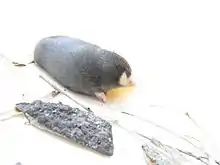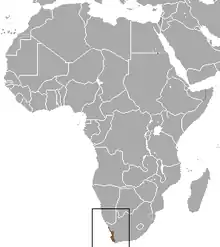Cape golden mole
The Cape golden mole (Chrysochloris asiatica) is a small, insectivorous mammal of the family Chrysochloridae, the golden moles. The species is a solitary subterranean insectivore, confined to the coastal regions of the southwestern and southern Cape in South Africa. When foraging for small, soil invertebrates and small lizards, these golden moles excavate superficial burrows using their conical nose shield and highly modified forefeet.[2] Females are smaller than males. Golden moles have very dense, soft, and silky coats. The coats are colored blackish to slaty-grey and brown to pale fawn. They have also been observed to venture onto sandy beaches, presumably to feed on amphipods and isopods occurring there.[3]
| Chrysochloris asiatica | |
|---|---|
 | |
| Cape golden mole adult, showing the digging claw, absence of external eye and a hint of the iridescence of the fur. | |
| Scientific classification | |
| Domain: | Eukaryota |
| Kingdom: | Animalia |
| Phylum: | Chordata |
| Class: | Mammalia |
| Order: | Afrosoricida |
| Family: | Chrysochloridae |
| Genus: | Chrysochloris |
| Species: | C. asiatica |
| Binomial name | |
| Chrysochloris asiatica | |
 | |
| Cape golden mole range | |
| Synonyms | |
|
List
| |
References
- Bronner, G. (2015). "Chrysochloris asiatica". IUCN Red List of Threatened Species. 2015: e.T40600A21288387. doi:10.2305/IUCN.UK.2015-2.RLTS.T40600A21288387.en. Retrieved 13 November 2021.
- "Chrysochloris asiatica (Cape golden mole)". Animal Diversity Web.
- BENNETT, AND SPINKS (1995). "hermoregulation and metabolism in the Cape golden mole (Insectivora: Chrysochloris asiatica)". Journal of Zoology, London. 236 (3): 521–529. doi:10.1111/j.1469-7998.1995.tb02729.x.
External links
- Manyeleti Private Game Reserve - description of golden moles
 Data related to Cape golden mole at Wikispecies
Data related to Cape golden mole at Wikispecies
This article is issued from Wikipedia. The text is licensed under Creative Commons - Attribution - Sharealike. Additional terms may apply for the media files.
